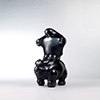EXHIBITED:
Li Chen – Energy of Emptiness, 52nd Venice Biennale, Venice, June 8-November 21, 2007
Li Chen: In Search of Spiritual Space, National Museum of China, Beijing, April 29-May 11, 2008
Li Chen: Mind, Body, Spirit, Singapore Art Museum, Singapore, September 17-December 9, 2009 (larger version)
Great of Spirit – Li Chen Premiere Sculpture Exhibition in Taiwan, Chang Kai-shek Memorial Hall, Taipei, November 6-December 4, 2011 (larger version)
Li Chen’s Major Sculpture Solo Exhibition, Place Vendome, Paris, September 2-29, 2013 (larger version)
ILLUSTRATED:
Li Chen 1992-2002 Sculpture, Asia Art Center, Taipei, 2004, color illustrated, pp. 82-83
Li Chen in Venice 52nd Venice Biennale - Energy of Emptiness, Asia Art Center, Taipei, 2007, color illustrated, pp. 118-129 & p. 219
Li Chen in Beijing - In Search of Spiritual Space, Asia Art Center, Taipei, 2008, color illustrated, pp. 50-57 & back cover
Li Chen: Mind, Body, Spirit, Singapore Art Museum, Singapore, 2010, color illustrated, pp. 94-103; black-and-white illustrated, p. 183 (larger version)
Great of Spirit – Li Chen Premiere Sculpture Exhibition in Taiwan, Asia Art Center, Taipei, 2011, color illustrated, p. 59 & pp. 78-79 (larger version)
This sculpture is to be sold with a certificate of authenticity issued by Asia Art Center, Taipei.
Catalogue Note:
During the early stage of his artistic creation, Li Chen dabbled in a large amount of Buddhist and Daoist classics and became enamored with Buddha statues in museums and monuments. In his pursuit of art, he engages in conveying the profundity of Eastern culture with his simple and pristine style through sculpture. “Dragon-Riding Bodhisattva”, created in 2001, is considered a highly representative piece by Li and an extension of his work Avalokitesvara made in 1999. Li invokes the folk belief of Bodhisattva riding on a dragon. By exerting his reserved and steady thinking, he endows this legendary story with a simple, harmonious, and wise contemporary image. The ink-black appearance makes this sculpture appear as a powerful heavy boulder when viewed from a distance and yet, upon closer examination, the piece seems to become a delicate, glowing lacquerwork. The steady and airy Buddha with open arms exemplifies the changing shapes in sculpture art.
Li makes breakthroughs in existing styles of Buddhist sculpture which have existed for over a millennium. He alters the thick and full Tang Dynasty (A.D. 618-907) style Buddhist sculptures and the elegantly spiritual characteristics of Song Dynasty (A.D. 960-1279) sculptures, reaching an extreme simplification in both face and line. He extracts elements of China's five thousand years of history and culture, including Chinese immortals, Buddhas, dragons, fairytales, and folk tales, and takes them a step further to create unabashedly contemporary artwork. Furthermore, he successfully combines classical and contemporary perspectives and creates works that possess unprecedented and unique forms, endowing new life to Eastern sculpture. Such an artistic achievement is truly rare in the contemporary art scene.


